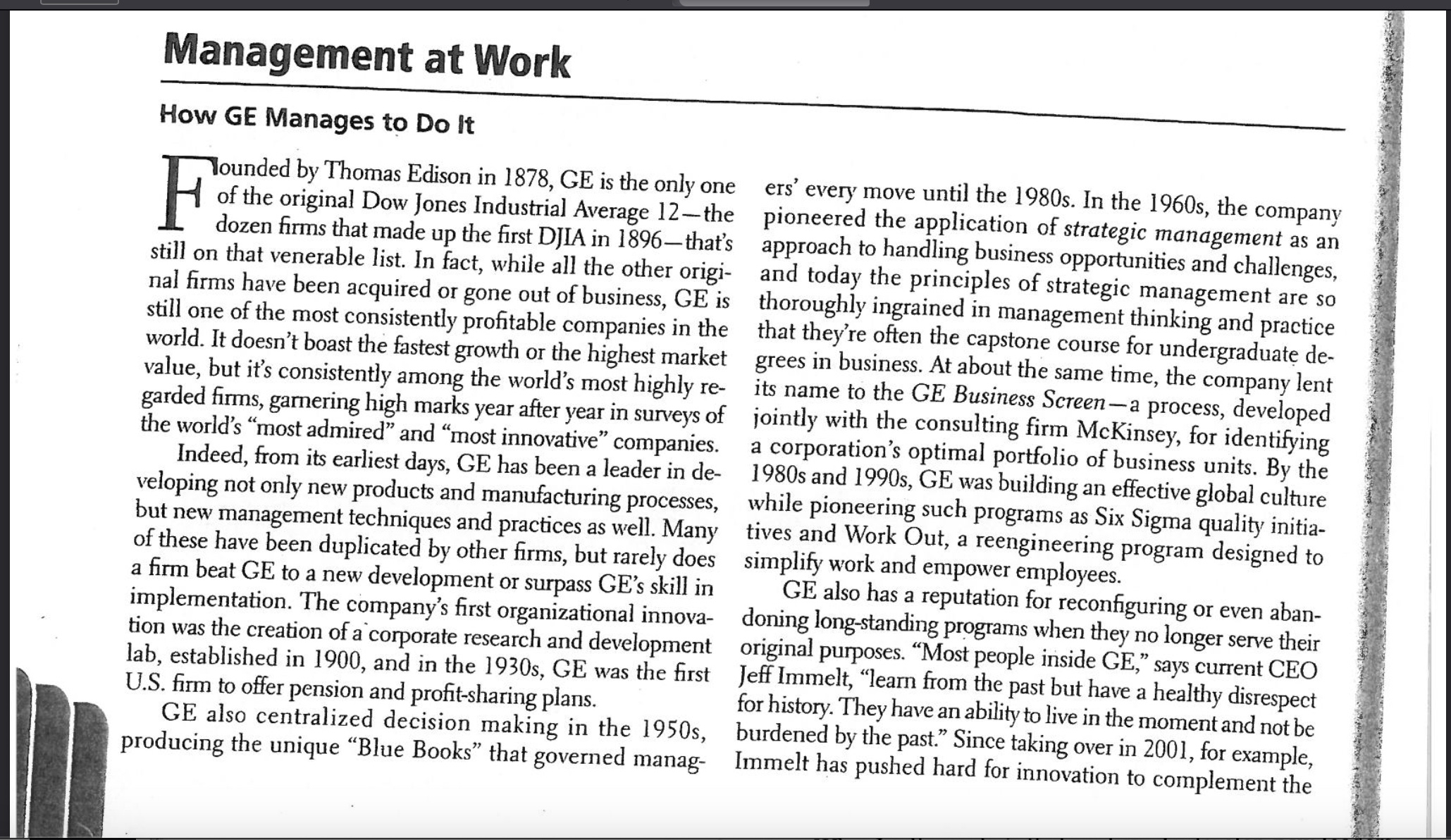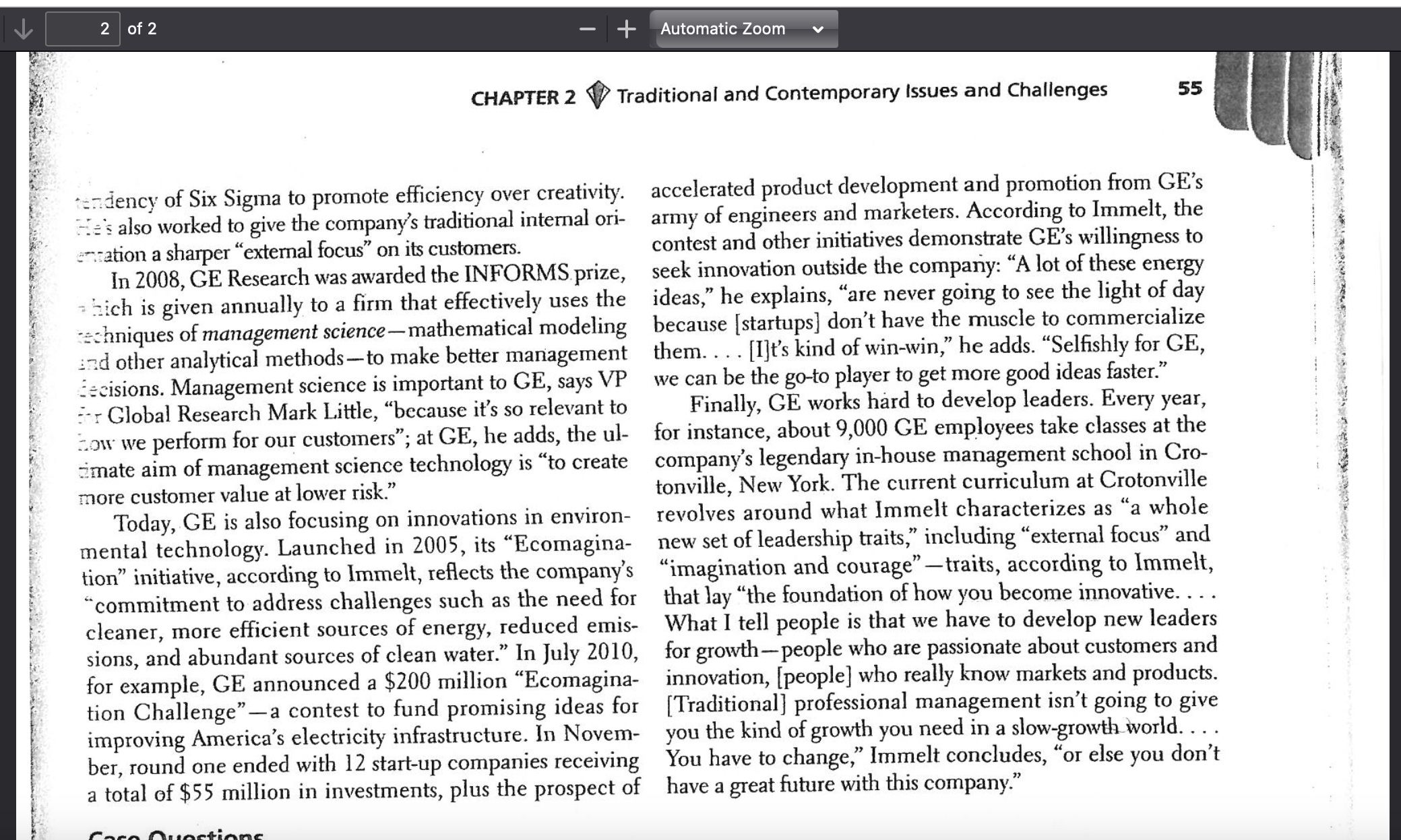Answered step by step
Verified Expert Solution
Question
1 Approved Answer
Provide a paragraph summary of this case study Tounded by Thomas Edison in 1878, GE is the only one of the original Dow Jones Industrial


Provide a paragraph summary of this case study
Tounded by Thomas Edison in 1878, GE is the only one of the original Dow Jones Industrial Average 12-the 1 dozen firms that made up the first DJIA in 1896-that's still on that venerable list. In fact, while all the other original firms have been acquired or gone out of business, GE is still one of the most consistently profitable companies in the world. It doesn't boast the fastest growth or the highest market value, but it's consistently among the world's most highly regarded firms, garnering high marks year after year in surveys of the world's "most admired" and "most innovative" companies. Indeed, from its earliest days, GE has been a leader in developing not only new products and manufacturing processes, but new management techniques and practices as well. Many of these have been duplicated by other firms, but rarely does a firm beat GE to a new development or surpass GE's skill in implementation. The company's first organizational innovation was the creation of a corporate research and development lab, established in 1900, and in the 1930s, GE was the first U.S. firm to offer pension and profit-sharing plans. GE also centralized decision making in the 1950 s, producing the unique "Blue Books" that governed manag- ers' every move until the 1980s. In the 1960s, the company pioneered the application of strategic management as an approach to handling business opportunities and challenges, and today the principles of strategic management are so thoroughly ingrained in management thinking and practice that they're often the capstone course for undergraduate degrees in business. At about the same time, the company lent its name to the GE Business Screen-a process, developed jointly with the consulting firm McKinsey, for identifying a corporation's optimal portfolio of business units. By the 1980 s and 1990s, GE was building an effective global culture while pioneering such programs as Six Sigma quality initiatives and Work Out, a reengineering program designed to simplify work and empower employees. GE also has a reputation for reconfiguring or even abandoning long-standing programs when they no longer serve their original purposes. "Most people inside GE," says current CEO Jeff Immelt, "learn from the past but have a healthy disrespect for history. They have an ability to live in the moment and not be burdened by the past." Since taking over in 2001, for example, Immelt has pushed hard for innovation to complement the CHAPTER 2 Traditional and Contemporary Issues and Challenges 55 t--jency of Six Sigma to promote efficiency over creativity. also worked to give the company's traditional internal ori-ration a sharper "external focus" on its customers. In 2008, GE Research was awarded the INFORMS prize, - Hich is given annually to a firm that effectively uses the schniques of management science - mathematical modeling ind other analytical methods - to make better management Ecisions. Management science is important to GE, says VP Global Research Mark Little, "because it's so relevant to Dow we perform for our customers"; at GE, he adds, the ulimate aim of management science technology is "to create more customer value at lower risk." Today, GE is also focusing on innovations in environmental technology. Launched in 2005, its "Ecomagination" initiative, according to Immelt, reflects the company's "commitment to address challenges such as the need for cleaner, more efficient sources of energy, reduced emissions, and abundant sources of clean water." In July 2010, for example, GE announced a $200 million "Ecomagination Challenge" - a contest to fund promising ideas for improving America's electricity infrastructure. In November, round one ended with 12 start-up companies receiving a total of $55 million in investments, plus the prospect of accelerated product development and promotion from GE's army of engineers and marketers. According to Immelt, the contest and other initiatives demonstrate GE's willingness to seek innovation outside the company: "A lot of these energy ideas," he explains, "are never going to see the light of day because [startups] don't have the muscle to commercialize them. . . [I]t's kind of win-win," he adds. "Selfishly for GE, we can be the go-to player to get more good ideas faster." Finally, GE works hard to develop leaders. Every year, for instance, about 9,000 GE employees take classes at the company's legendary in-house management school in Crotonville, New York. The current curriculum at Crotonville revolves around what Immelt characterizes as "a whole new set of leadership traits," including "external focus" and "imagination and courage" - traits, according to Immelt, that lay "the foundation of how you become innovative. ... What I tell people is that we have to develop new leaders for growth-people who are passionate about customers and innovation, [people] who really know markets and products. [Traditional] professional management isn't going to give you the kind of growth you need in a slow-growth world. . . . You have to change," Immelt concludes, or else you don't have a great future with this companyStep by Step Solution
There are 3 Steps involved in it
Step: 1

Get Instant Access to Expert-Tailored Solutions
See step-by-step solutions with expert insights and AI powered tools for academic success
Step: 2

Step: 3

Ace Your Homework with AI
Get the answers you need in no time with our AI-driven, step-by-step assistance
Get Started


